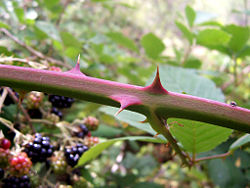Difference between revisions of "Plant" - New World Encyclopedia
Miriam Jones (talk | contribs) |
Miriam Jones (talk | contribs) |
||
| Line 34: | Line 34: | ||
[[Aristotle]] divided all living things between plants, which generally do not move or have sensory organs, and [[animal]]s. In Carolus Linnaeus' system, these became the Kingdoms Vegetabilia (later Plantae) and [[Animal]]ia. Since then, it has become clear that the Plantae as originally defined included several unrelated groups, and the [[fungus|fungi]] and several groups of [[alga]]e were removed to new kingdoms. However, these are still often considered plants in many contexts. Indeed, any attempt to match "plant" with a single taxon is doomed to fail, because plant is a vaguely defined concept unrelated to the presumed phylogenic concepts on which modern [[taxonomy]] is based. | [[Aristotle]] divided all living things between plants, which generally do not move or have sensory organs, and [[animal]]s. In Carolus Linnaeus' system, these became the Kingdoms Vegetabilia (later Plantae) and [[Animal]]ia. Since then, it has become clear that the Plantae as originally defined included several unrelated groups, and the [[fungus|fungi]] and several groups of [[alga]]e were removed to new kingdoms. However, these are still often considered plants in many contexts. Indeed, any attempt to match "plant" with a single taxon is doomed to fail, because plant is a vaguely defined concept unrelated to the presumed phylogenic concepts on which modern [[taxonomy]] is based. | ||
| − | ==Embryophytes== | + | ==Vascular Plants== |
| + | ===Embryophytes=== | ||
The most familiar plants are the multicellular land plants with specialized reproductive organs, called '''embryophytes'''. They include the [[vascular plant]]s, plants with full systems of [[leaf|leaves]], stems, and [[root]]s. They also include a few of their close relatives, often called ''[[bryophyte]]s'', of which mosses and liverworts are the most common. | The most familiar plants are the multicellular land plants with specialized reproductive organs, called '''embryophytes'''. They include the [[vascular plant]]s, plants with full systems of [[leaf|leaves]], stems, and [[root]]s. They also include a few of their close relatives, often called ''[[bryophyte]]s'', of which mosses and liverworts are the most common. | ||
All of these plants have [[eukaryote|eukaryotic]] cells with [[cell]] walls composed of [[cellulose]], and most obtain their [[energy]] through [[photosynthesis]], using [[light]] and carbon dioxide to synthesize food. About three hundred plant [[species]] do not photosynthesize but are parasites on other [[species]] of photosynthetic plants. Plants are distinguished from green [[algae]], from which they evolved, by having specialized reproductive organs protected by non-reproductive tissues. | All of these plants have [[eukaryote|eukaryotic]] cells with [[cell]] walls composed of [[cellulose]], and most obtain their [[energy]] through [[photosynthesis]], using [[light]] and carbon dioxide to synthesize food. About three hundred plant [[species]] do not photosynthesize but are parasites on other [[species]] of photosynthetic plants. Plants are distinguished from green [[algae]], from which they evolved, by having specialized reproductive organs protected by non-reproductive tissues. | ||
| + | ====Seed Plants==== | ||
| + | The '''spermatophytes''' (also known as '''phanerogams''') comprise those plants that produce [[seed]]s. They are a subset of the embryophytes or land plants: living spermatophytes include [[cycad]]s, ''Ginkgo'', conifers, gnetae, and [[angiosperm]]s | ||
| + | |||
| + | Seed-bearing plants were traditionally divided into [[angiosperm]]s, or flowering plants, and [[gymnosperm]]s, which includes the gnetae, cycads, ginkgo, and conifers. Angiosperms are now thought to have evolved from a gymnosperm ancestor, which would make gymnosperms a paraphyletic group if it includes extinct taxa. Modern [[cladistics]] attempts to define taxa that are monophyletic, traceable to a common ancestor and inclusive therefore of all descendants of that common ancestor. Although not a monophyletic taxonomic unit, "gymnosperm" is still widely used to distinguish the four taxa of non-flowering, seed-bearing plants from the angiosperms. | ||
| + | |||
| + | Molecular phylogenies have conflicted with morphologically-based evidence as to whether extant gymnosperms comprise a monophyletic group. Some morphological data suggests that the Gnetophytes are the sister-group to angiosperms, but molecular phylogenies have generally shown a monophyletic gymnosperm clade that includes the Gnetophytes as sister-group to the conifers. | ||
| + | |||
| + | The fossil record contains evidence of many [[extinction|extinct]] taxa of seed plants. The so-called "seed ferns" (Pteridospermae) were one of the earliest successful groups of land plants, and forests dominated by seed ferns were prevalent in the late Paleozoic. ''Glossopteris'' was the most prominent [[tree]] genus in the ancient southern supercontinent of Gondwana during the Permian period. By the Triassic period, seed ferns had declined in [[ecology|ecological]] importance, and representatives of modern [[gymnosperm]] groups were abundant and dominant through the end of the Cretaceous, when [[angiosperm]]s radiated. | ||
| + | |||
| + | Modern classification classifies the seed plants as follows: | ||
| + | *'''Cycadophyta''', the cycads | ||
| + | *'''Ginkgophyta''', the ginkgo | ||
| + | *'''Pinophyta''', the conifers | ||
| + | *'''Gnetophyta''', including ''Gnetum'', ''Welwitschia'', ''Ephedra'' | ||
| + | *'''[[Flowering plant|Magnoliophyta]]''', the [[flowering plant]]s | ||
| + | |||
| + | ===Non-embryophytic Plants=== | ||
| + | Some plants live [[symbiosis|symbiotically]] off of other organisms ('''myco-heterotrophs''') rather than producing food through [[photosynthesis]]. Most of these are actually [[fungi]], but some plants, such as ''Monotropastrum humile'' and ''Monotropa hypopitys,''in the Ericaceae family, contain no [[chlorophyll]] and obtain nutrients from non-living organic matter. '''Mycotrophs''' engage in mutualistic mycorrhizal relationships, where a [[fungus]] attaches to a host plant's [[root]]s. The fungus obtains sugars produced by the plant, and the fungus aids the plant in absorbing essential nutrients from the soil. These mycorrhizal plants are mostly photosynthetic. | ||
| + | |||
| + | ==Nonvascular Plants== | ||
| + | '''Non-vascular plants''' include those land plants without a vascular system. [[Bryophyte]]s - the Bryophyta (mosses), the Hepaticophyta (liverworts), and the Anthocerotophyta (hornworts), are the only nonvascular plants grouped within the Kingdom Plantae. In these groups, the primary plants are haploid, with the only diploid portion being the attached sporophyte, consisting of a stalk and sporangium. Because these plants lack the water-conducting tissues, they fail to achieve the structural complexity and size of most [[vascular plant]]s. | ||
| + | Some algae - especially the [[green algae]]- are also nonvascular, but these are no longer grouped in the plant kingdom. Recent studies have demonstrated that the algae actually consist of several unrelated groups. It turns out that common features of living in water and [[photosynthesis]] were misleading as indicators of close relationship. Only the green algae are still considered relatives of the plants. | ||
| + | |||
| + | Both of these groups may be termed the "lower" plants; the term "lower" refers to these plants' status as the earliest plants to [[evolve]]. However, the term "lower" plants is not precise, since it frequently is used to include some [[vascular]] plants, the [[fern]]s and [[fern ally|fern allies]]. | ||
| + | |||
==Plant History and Evolution== | ==Plant History and Evolution== | ||
| Line 95: | Line 121: | ||
== References and further reading == | == References and further reading == | ||
| + | *Bowe, L. Michelle, Gwénaële Coat, and Claude W. dePamphilis. 2000. Phylogeny of seed plants based on all three genomic compartments: Extant gymnosperms are monophyletic and Gnetales' closest relatives are conifers. ''Proceedings of the National Academy of Sciences'' 97: 4092-4097. | ||
| + | *Soltis, Douglas E., Pamela S. Soltis and Michael J. Zanis. 2002. Phylogeny of seed plants based on evidence from eight genes. ''American Journal of Botany'' 89: 1670-1681 (abstract [http://intl.amjbot.org/cgi/content/full/89/10/1670 here]). | ||
| + | *Chaw, Shu-Miaw, Christopher L. Parkinson, Yuchang Cheng, Thomas M. Vincent, and Jeffrey D. Palmer. 2000. Seed plant phylogeny inferred from all three plant genomes: Monophyly of extant gymnosperms and origin of Gnetales from conifers. ''Proceedings of the National Academy of Sciences'' 97: 4086-4091 (abstract [http://www.pnas.org/cgi/content/abstract/97/8/4086 here]). | ||
* Species estimate and counts: | * Species estimate and counts: | ||
**Prance, G. T. (2001). Discovering the Plant World. ''Taxon'' 50: 345-359. | **Prance, G. T. (2001). Discovering the Plant World. ''Taxon'' 50: 345-359. | ||
Revision as of 14:41, 23 July 2006
| Plants | ||||
|---|---|---|---|---|
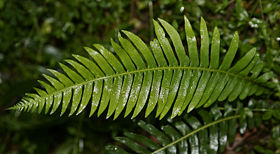 Fern frond | ||||
| Scientific classification | ||||
| ||||
| Divisions | ||||
|
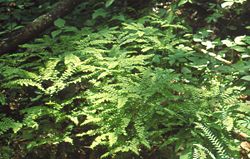
Plants are eukaryotic, multicellular, nonmotile photosynthetic organisms, and comprise one of the five Kingdoms of living things, Plantae. They are classified as plants by their ability to create food through photosynthesize, have cell walls composed of cellulose, do not have a central nervous system, and reproduce by alternation of generations. This kingdom includes familiar organisms such as trees, flowers, shrubs, herbs, and ferns. About 350,000 species of plants have been estimated to exist. As of 2004, some 287,655 species had been identified, of which 258,650 are flowering.
Aristotle divided all living things between plants, which generally do not move or have sensory organs, and animals. In Carolus Linnaeus' system, these became the Kingdoms Vegetabilia (later Plantae) and Animalia. Since then, it has become clear that the Plantae as originally defined included several unrelated groups, and the fungi and several groups of algae were removed to new kingdoms. However, these are still often considered plants in many contexts. Indeed, any attempt to match "plant" with a single taxon is doomed to fail, because plant is a vaguely defined concept unrelated to the presumed phylogenic concepts on which modern taxonomy is based.
Vascular Plants
Embryophytes
The most familiar plants are the multicellular land plants with specialized reproductive organs, called embryophytes. They include the vascular plants, plants with full systems of leaves, stems, and roots. They also include a few of their close relatives, often called bryophytes, of which mosses and liverworts are the most common.
All of these plants have eukaryotic cells with cell walls composed of cellulose, and most obtain their energy through photosynthesis, using light and carbon dioxide to synthesize food. About three hundred plant species do not photosynthesize but are parasites on other species of photosynthetic plants. Plants are distinguished from green algae, from which they evolved, by having specialized reproductive organs protected by non-reproductive tissues.
Seed Plants
The spermatophytes (also known as phanerogams) comprise those plants that produce seeds. They are a subset of the embryophytes or land plants: living spermatophytes include cycads, Ginkgo, conifers, gnetae, and angiosperms
Seed-bearing plants were traditionally divided into angiosperms, or flowering plants, and gymnosperms, which includes the gnetae, cycads, ginkgo, and conifers. Angiosperms are now thought to have evolved from a gymnosperm ancestor, which would make gymnosperms a paraphyletic group if it includes extinct taxa. Modern cladistics attempts to define taxa that are monophyletic, traceable to a common ancestor and inclusive therefore of all descendants of that common ancestor. Although not a monophyletic taxonomic unit, "gymnosperm" is still widely used to distinguish the four taxa of non-flowering, seed-bearing plants from the angiosperms.
Molecular phylogenies have conflicted with morphologically-based evidence as to whether extant gymnosperms comprise a monophyletic group. Some morphological data suggests that the Gnetophytes are the sister-group to angiosperms, but molecular phylogenies have generally shown a monophyletic gymnosperm clade that includes the Gnetophytes as sister-group to the conifers.
The fossil record contains evidence of many extinct taxa of seed plants. The so-called "seed ferns" (Pteridospermae) were one of the earliest successful groups of land plants, and forests dominated by seed ferns were prevalent in the late Paleozoic. Glossopteris was the most prominent tree genus in the ancient southern supercontinent of Gondwana during the Permian period. By the Triassic period, seed ferns had declined in ecological importance, and representatives of modern gymnosperm groups were abundant and dominant through the end of the Cretaceous, when angiosperms radiated.
Modern classification classifies the seed plants as follows:
- Cycadophyta, the cycads
- Ginkgophyta, the ginkgo
- Pinophyta, the conifers
- Gnetophyta, including Gnetum, Welwitschia, Ephedra
- Magnoliophyta, the flowering plants
Non-embryophytic Plants
Some plants live symbiotically off of other organisms (myco-heterotrophs) rather than producing food through photosynthesis. Most of these are actually fungi, but some plants, such as Monotropastrum humile and Monotropa hypopitys,in the Ericaceae family, contain no chlorophyll and obtain nutrients from non-living organic matter. Mycotrophs engage in mutualistic mycorrhizal relationships, where a fungus attaches to a host plant's roots. The fungus obtains sugars produced by the plant, and the fungus aids the plant in absorbing essential nutrients from the soil. These mycorrhizal plants are mostly photosynthetic.
Nonvascular Plants
Non-vascular plants include those land plants without a vascular system. Bryophytes - the Bryophyta (mosses), the Hepaticophyta (liverworts), and the Anthocerotophyta (hornworts), are the only nonvascular plants grouped within the Kingdom Plantae. In these groups, the primary plants are haploid, with the only diploid portion being the attached sporophyte, consisting of a stalk and sporangium. Because these plants lack the water-conducting tissues, they fail to achieve the structural complexity and size of most vascular plants. Some algae - especially the green algae- are also nonvascular, but these are no longer grouped in the plant kingdom. Recent studies have demonstrated that the algae actually consist of several unrelated groups. It turns out that common features of living in water and photosynthesis were misleading as indicators of close relationship. Only the green algae are still considered relatives of the plants.
Both of these groups may be termed the "lower" plants; the term "lower" refers to these plants' status as the earliest plants to evolve. However, the term "lower" plants is not precise, since it frequently is used to include some vascular plants, the ferns and fern allies.
Plant History and Evolution
Bryophytes first appeared during the early Palaeozoic (~450 million years ago). They can only survive where moisture is available for significant periods, although some species are desiccation tolerant. Most species of bryophyte remain small throughout their life cycle. This involves an alternation between two generations: a haploid stage, called the gametophyte, and a diploid stage, called the sporophyte. The sporophyte is short-lived and remains dependent on its parent gametophyte.
Vascular plants first appeared during the Silurian (450-415 million years ago) period, and by the Devonian (415 million years ago) had diversified and spread into many different land environments. They have a number of adaptations that allowed them to overcome the limitations of the bryophytes. These include a cuticle resistant to desiccation, and vascular tissues which transport water throughout the organism. In most the sporophyte acts as a separate individual, while the gametophyte remains small.
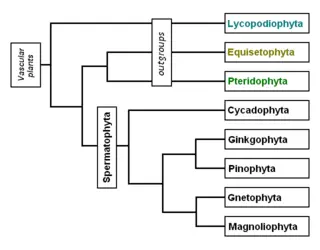
The first primitive seed plants, Pteridosperms (seed ferns) and Cordaites, both groups now extinct, appeared in the late Devonian and diversified through the Carboniferous, with further evolution through the Permian and Triassic periods. In these the gametophyte stage is completely reduced, and the sporophyte begins life inside an enclosure called a seed, which develops while on the parent plant, and with fertilisation by means of pollen grains. Whereas other vascular plants, such as ferns, reproduce by means of spores and so need moisture to develop, some seed plants can survive and reproduce in extremely arid conditions.
Early seed plants are referred to as gymnosperms (naked seeds), as the seed embryo is not enclosed in a protective structure at pollination, with the pollen landing directly on the embryo. Four surviving groups remain widespread now, particularly the conifers, which are dominant trees in several biomes. The angiosperms, comprising the flowering plants, were the last major group of plants to appear, emerging from within the gymnosperms during the Jurassic (200-160 million years ago) and diversifying rapidly during the Cretaceous (100-150 million years ago). These differ in that the seed embryo is enclosed, so the pollen has to grow a tube to penetrate the protective seed coat; they are the predominant group of flora in most biomes today.
Fossils
Plant fossils include roots, wood, leaves, seeds, fruit, pollen, spores, phytoliths, and amber (the fossilized resin produced by some plants). Fossil land plants are recorded in terrestrial, lacustrine, fluvial and nearshore marine sediments. Pollen, spores and algae (dinoflagellates and acritarchs) are used for dating sedimentary rock sequences. The remains of fossil plants are not as common as fossil animals, although plant fossils are locally abundant in many regions worldwide.
Early fossils of these ancient plants show the individual cells within the plant tissue. The Devonian period also saw the evolution of what many believe to be the first modern tree, Archaeopteris. This fern-like tree combined a woody trunk with the fronds of a fern, but produced no seeds.
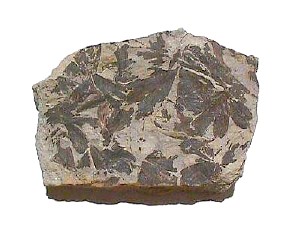
The Coal Measures are a major source of Palaeozoic plant fossils, with many groups of plants in existence at this time. The spoil heaps of coal mines are the best places to collect; coal itself is the remains of fossilised plants, though structural detail of the plant fossils is rarely visible in coal. In the Fossil Forest at Victoria Park in Glasgow, Scotland, the stumps of Lepidodendron trees are found in their original growth positions.
The fossilized remains of conifer and angiosperm roots, stems and branches may be locally abundant in lake and inshore sedimentary rocks from the Mesozoic and Cenozoic eras. Sequoia and its allies, magnolia, oak, and palms are often found.
Petrified wood is common in some parts of the world, and is most frequently found in arid or desert areas where it is more readily exposed by erosion. Petrified wood is often heavily silicified (the organic material replaced by silicon dioxide), and the impregnated tissue is often preserved in fine detail. Such specimens may be cut and polished using lapidary equipment. Fossil forests of petrified wood have been found in all continents.
Fossils of seed ferns such as Glossopteris are widely distributed throughout several continents of the southern hemisphere, a fact that gave support to Alfred Wegener's early ideas regarding Continental drift theory.
Algae and Fungi
The algae comprise several different groups of organisms that produce energy through photosynthesis. However, they are not classified within the Kingdom Plantae but mostly in the Kingdom Protista. Most conspicuous are the seaweeds, multicellular algae that may roughly resemble terrestrial plants, but are classified among the green, red, and brown algae. These and other algal groups also include various single-celled organisms.
The embryophytes developed from green algae; the two groups are collectively referred to as the green plants or Viridiplantae. The Kingdom Plantae is often taken to mean this monophyletic grouping. With a few exceptions among the green algae, all such forms have cell walls containing cellulose and chloroplasts containing chlorophylls a and b, and store food in the form of starch. They undergo closed mitosis without centrioles (barrel-shaped microtubules that aids in the cell division process), and typically have mitochondria with flat cristae.
The chloroplasts of green plants are surrounded by two membranes, suggesting they originated directly from endosymbiotic cyanobacteria. The same is true of the red algae, and the two groups are generally believed to have a common origin. In contrast, most other algae have chloroplasts with three or four membranes. They are not close relatives of the green plants, presumably in origin acquiring chloroplasts separately from ingested or symbiotic green and red algae.
Unlike embryophytes and algae, fungi are not photosynthetic, but are saprophytic, obtaining food by breaking down and absorbing surrounding materials. Most fungi are formed by microscopic structures called hyphae, which may or may not be divided into cells but contain eukaryotic nuclei. Fruiting bodies, of which mushrooms are most familiar, are the reproductive structures of fungi. They are not related to any of the photosynthetic groups, but are close relatives of animals. Therefore, the fungi are in a kingdom of their own.
Importance
The photosynthesis and carbon fixation conducted by land plants and algae are the ultimate source of energy and organic material in nearly all ecosystems. These processes radically changed the composition of the early Earth's atmosphere, which as a result is now 20% oxygen. Animals and most other organisms are aerobic, relying on oxygen; those that do not are confined to relatively rare anaerobic, oxygen-depleted, environments.
Much of human nutrition depends on cereals. Other plants that are eaten include fruits, vegetables, legumes herbs, and spices. Strict vegetarians rely entirely on plants (as well as some algae and fungi) for their nutrition. Some vascular plants, referred to as trees and shrubs, produce woody stems and are an important source of building material. A number of plants are used decoratively, including a variety of flowers, and in landscaping.
Growth
It is a common misconception that most of the solid material in a plant is taken from the soil, when in fact almost all of it is actually taken from the atmosphere. Through a process known as photosynthesis, plants use the energy in sunlight to convert carbon dioxide from the atmosphere into simple sugars. These sugars are then used as building blocks and form the main structural component of the plant. Plants rely on soil primarily for water (in quantitative terms), but also obtain nitrogen, phosphorus and other crucial elemental nutrients.
Simple plants like algae may have short life spans as individuals, but their populations are commonly seasonal. Other plants may be organized according to their seasonal growth pattern:
- Annual: live and reproduce within one growing season.
- Biennial: live for two growing seasons; usually reproduce in second year.
- Perennial: live for many growing seasons; continue to reproduce once mature.
Among the vascular plants, perennials include both evergreens that keep their leaves the entire year, and deciduous plants which lose their leaves for some part. In temperate and boreal climates, they generally lose their leaves during the winter; many tropical plants lose their leaves during the dry season.
The growth rate of plants is extremely variable. Some mosses grow less than 0.001 mm/h, while most trees grow 0.025-0.250 mm/h. Some climbing species, such as kudzu, which do not need to produce thick supportive tissue, may grow up to 12.5 mm/h.
Distribution
Plants are found throughout the world, both on land and in water bodies. Plants are most abundant where resources (water, sunlight, adequate growth temperatures) are most abundant, and accordingly, the tropics overwhelmingly contain the greatest biomass and species diversity. The mostly dry, subtropical regions contain highly specialized, dessication-tolerant species, and the landscape is often sparse. The temperate midlatitudes once again increase in biodiversity and biomass, but for the most part do not surpass the tropics in either. Poleward of the midlatitudes biodiversity decreases, and tundra dominates. Poleward of the arctic circle, vegetation growth is highly seasonal, as it remains dark for a significant portion of the year, preventing photosynthesis from occurring. (Please see biome article for more detailed discussion on global distribution of plants and their biomes.)
References and further reading
- Bowe, L. Michelle, Gwénaële Coat, and Claude W. dePamphilis. 2000. Phylogeny of seed plants based on all three genomic compartments: Extant gymnosperms are monophyletic and Gnetales' closest relatives are conifers. Proceedings of the National Academy of Sciences 97: 4092-4097.
- Soltis, Douglas E., Pamela S. Soltis and Michael J. Zanis. 2002. Phylogeny of seed plants based on evidence from eight genes. American Journal of Botany 89: 1670-1681 (abstract here).
- Chaw, Shu-Miaw, Christopher L. Parkinson, Yuchang Cheng, Thomas M. Vincent, and Jeffrey D. Palmer. 2000. Seed plant phylogeny inferred from all three plant genomes: Monophyly of extant gymnosperms and origin of Gnetales from conifers. Proceedings of the National Academy of Sciences 97: 4086-4091 (abstract here).
- Species estimate and counts:
- Prance, G. T. (2001). Discovering the Plant World. Taxon 50: 345-359.
- International Union for Conservation of Nature and Natural Resources (IUCN) Species Survival Commission (2004). IUCN Red List of Threatened Species [1].
- Both the above are cited in Nature Conservancy, Spring 2006, p. 14.
- Kenrick, Paul & Crane, Peter R. (1997). The Origin and Early Diversification of Land Plants: A Cladistic Study. Washington, D. C.: Smithsonian Institution Press. ISBN 1-56098-730-8.
- Raven, Peter H., Evert, Ray F., & Eichhorn, Susan E. (2005). Biology of Plants (7th ed.). New York: W. H. Freeman and Company. ISBN 0-7167-1007-2.
- Taylor, Thomas N. & Taylor, Edith L. (1993). The Biology and Evolution of Fossil Plants. Englewood Cliffs, NJ: Prentice Hall. ISBN 0-13-651589-4.
- Evans, L.T. (1998). Feeding the Ten Billion - Plants and Population Growth. Cambridge University Press. Paperback, 247 pages ISBN. 0-521-64685-5.
See also
External links
- Tree of Life
- Chaw, S.-M. et al. (1997). Molecular Phylogeny of Extant Gymnosperms and Seed Plant Evolution: Analysis of Nuclear 18s rRNA Sequences. Molec. Biol. Evol 14 (1): 56-68.
- Interactive Cronquist classification
Botanical and vegetation databases
- e-Floras (Flora of China, Flora of North America and others)
- United States of America
- Flora Europaea
- Australia
- 'Dave's Garden' horticultural plant database
- Chilean plants at Chilebosque
Credits
New World Encyclopedia writers and editors rewrote and completed the Wikipedia article in accordance with New World Encyclopedia standards. This article abides by terms of the Creative Commons CC-by-sa 3.0 License (CC-by-sa), which may be used and disseminated with proper attribution. Credit is due under the terms of this license that can reference both the New World Encyclopedia contributors and the selfless volunteer contributors of the Wikimedia Foundation. To cite this article click here for a list of acceptable citing formats.The history of earlier contributions by wikipedians is accessible to researchers here:
The history of this article since it was imported to New World Encyclopedia:
Note: Some restrictions may apply to use of individual images which are separately licensed.
